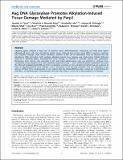Aag DNA Glycosylase Promotes Alkylation-Induced Tissue Damage Mediated by Parp1
Author(s)
Calvo, Jennifer A.; Moroski-Erkul, Catherine A.; Lake, Annabelle; Eichinger, Lindsey Wood; Shah, Dharini; Jhun, Iny; Limsirichai, Prajit; Bronson, Roderick T.; Christiani, David C.; Meira, Lisiane B.; Samson, Leona D.; ... Show more Show less
DownloadCalvo-2013-Aag DNA glycosylase.pdf (15.91Mb)
PUBLISHER_CC
Publisher with Creative Commons License
Creative Commons Attribution
Terms of use
Metadata
Show full item recordAbstract
Alkylating agents comprise a major class of front-line cancer chemotherapeutic compounds, and while these agents effectively kill tumor cells, they also damage healthy tissues. Although base excision repair (BER) is essential in repairing DNA alkylation damage, under certain conditions, initiation of BER can be detrimental. Here we illustrate that the alkyladenine DNA glycosylase (AAG) mediates alkylation-induced tissue damage and whole-animal lethality following exposure to alkylating agents. Aag-dependent tissue damage, as observed in cerebellar granule cells, splenocytes, thymocytes, bone marrow cells, pancreatic β-cells, and retinal photoreceptor cells, was detected in wild-type mice, exacerbated in Aag transgenic mice, and completely suppressed in Aag−/− mice. Additional genetic experiments dissected the effects of modulating both BER and Parp1 on alkylation sensitivity in mice and determined that Aag acts upstream of Parp1 in alkylation-induced tissue damage; in fact, cytotoxicity in WT and Aag transgenic mice was abrogated in the absence of Parp1. These results provide in vivo evidence that Aag-initiated BER may play a critical role in determining the side-effects of alkylating agent chemotherapies and that Parp1 plays a crucial role in Aag-mediated tissue damage.
Date issued
2013-04Department
Massachusetts Institute of Technology. Department of Biological EngineeringJournal
PLoS Genetics
Publisher
Public Library of Science
Citation
Calvo, Jennifer A., Catherine A. Moroski-Erkul, Annabelle Lake, Lindsey W. Eichinger, Dharini Shah, Iny Jhun, Prajit Limsirichai, et al. Aag DNA Glycosylase Promotes Alkylation-Induced Tissue Damage Mediated by Parp1. Edited by Samuel H. Wilson. PLoS Genetics 9, no. 4 (April 4, 2013): e1003413.
Version: Author's final manuscript
ISSN
1553-7404
1553-734X